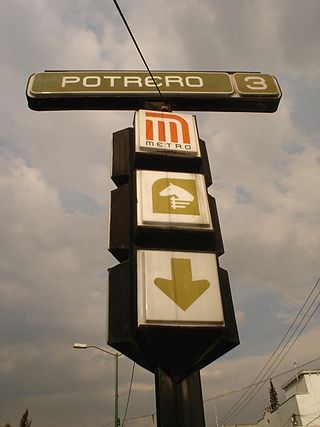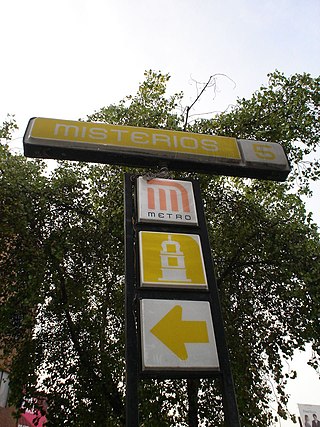
Aragón metro station is a Mexico City Metro station within the limits of Gustavo A. Madero and Venustiano Carranza, in Mexico City. It is an at-grade station with one island platform, served by Line 5, between Eduardo Molina and Oceanía stations. Aragón station serves the colonias of Casas Alemán and Simón Bolívar. The station is named after the San Juan de Aragón Park, and its pictogram represents the silhouette of a squirrel. Aragón metro station was opened on 19 December 1981, on the first day of the Consulado–Pantitlán service. In 2019, the station had an average daily ridership of 7,547 passengers, making it the 172nd busiest station in the network and the eighth busiest of the line.

La Raza metro station is a Mexico City Metro transfer station in the Gustavo A. Madero borough of Mexico City. It is a combined underground and at-grade station with two side platforms each, served by Lines 3 and 5. La Raza metro station is located between Potrero and Tlatelolco stations on Line 3, and between Autobuses del Norte and Misterios stations on Line 5. It serves the colonias (neighborhoods) of Vallejo and Héroes de Nacozari. The station's pictogram depicts the nearby Monumento a la Raza, a pyramid-shaped construction erected in honor of la Raza, Mexico's many native peoples and cultures.

Indios Verdes metro station is a station of the Mexico City Metro along Insurgentes Norte Avenue in the colonias (neighborhoods) of Residencial Zacatenco and Santa Isabel Tola, in Gustavo A. Madero, Mexico City. It is an at-grade station with two island platforms that serves as the northern terminus of Line 3. It is followed by Deportivo 18 de Marzo station. The station and its surrounding area are named this way because of the verdigris statues of Itzcoatl and Ahuitzotl, both Aztec rulers. They are located in Mestizaje Park and are collectively known as the Monumento a los Indios Verdes; the silhouettes of the statues are depicted in the pictogram. The station was opened on 1 December 1979, on the first day of service between Indios Verdes and Hospital General stations.

Potrero metro station is a station of the Mexico City Metro built along Insurgentes Norte Avenue in the colonias (neighborhoods) of Capultitlan and Guadalupe Insurgentes, in Gustavo A. Madero, Mexico City. It is an at-grade station with one island platform served by Line 3 between Deportivo 18 de Marzo and La Raza stations. The station and its surrounding area are named this way because there used to be a hippodrome during the Porfiriato era (1876–1911) and its pictogram features the silhouette of a head of a horse behind a fence. The station was opened on 1 December 1979, on the first day of service between Indios Verdes and Hospital General metro stations.

The Mexico City Metrobús, simply known as Metrobús, is a bus rapid transit (BRT) system that has served Mexico City since line 1 opened on 19 June 2005. As of February 2018, it consists of seven lines that cross the city and connects with other forms of transit, such as the Mexico City Metro. The most recent line to open was line 7, running for the first time double-decker buses along the city's iconic boulevard, Paseo de la Reforma.

Avenida de los Insurgentes, sometimes known simply as Insurgentes, is the longest avenue in Mexico City, with a length of 28.8 km (17.9 mi) on a north-south axis across the city. Insurgentes has its origins in what was during the early 20th century known as the Via del Centenario which ran from city centre to the southern suburbs.

Misterios metro station is a Mexico City Metro station within the limits of Cuauhtémoc and Gustavo A. Madero, in Mexico City. It is an underground station with two side platforms, served by Line 5, between La Raza and Valle Gómez stations. Misterios station serves the colonias (neighborhoods) of Peralvillo and Vallejo.

Eduardo Molina metro station is a Mexico City Metro station within the limits of Gustavo A. Madero and Venustiano Carranza, in Mexico City. It is an at-grade station with one island platform, served by Line 5, between Consulado and Aragón stations. Eduardo Molina station serves the colonias (neighborhoods) of 20 de Noviembre and Malinche. The station is named after Eduardo Molina Arévalo, an engineer who helped to solve the problem of water scarcity in the Valley of Mexico in the mid-20th century, and its pictogram represents two hands holding water, as featured on the mural El agua, origen de la vida, painted by Mexican muralist Diego Rivera in the Cárcamo de Dolores, in Chapultepec, Mexico City. Eduardo Molina metro station was opened on 19 December 1981, on the first day of the Consulado–Pantitlán service. In 2019, the station had an average daily ridership of 6,811 passengers, making it the 176th busiest station in the network and the ninth busiest of the line.

Ecatepec, officially Ecatepec de Morelos, is a municipality in the central Mexican state of Mexico, and is situated in the north part of the greater Mexico City urban area. The municipal seat is San Cristóbal Ecatepec.

Mexibús is a bus rapid transit (BRT) system that is located in the Greater Mexico City part of the State of Mexico, which surrounds Mexico City proper.

The Mexico City Metrobús Line 1 is a bus rapid transit line in the Mexico City Metrobús. It operates between Indios Verdes, in the Gustavo A. Madero municipality in the northern part of the city, and El Caminero, in Tlalpan in southern Mexico City. The line was the first one to be built and opened. The first section of the line, known as Corredor Insurgentes, was inaugurated by Andrés Manuel López Obrador, Head of Government of the Federal District from 2000 to 2005, on June 19, 2005. The second stretch of the line, known as Corredor Insurgentes Sur, was inaugurated on March 13, 2008, by Marcelo Ebrard, Head of Government of the Federal District from 2006 to 2012.

The Mexico City Metrobús Line 7 is a bus rapid transit line in the Mexico City Metrobús. It operates between Campo Marte in the Miguel Hidalgo borough and Indios Verdes, in Gustavo A. Madero in the northern part of the city. This is the newest line, inaugurated in March 2018.

The Mexico City Metrobús Line 3 is a bus rapid transit line in the Mexico City Metrobús. It operates between Tenayuca, in the limits with the State of Mexico in Gustavo A. Madero and Pueblo Santa Cruz Atoyac in the Benito Juárez boroughs, in southern Mexico City.

The Mexico City Metrobús Line 5 is a bus rapid transit line in the Mexico City Metrobus. It operates between Río de los Remedios in the boroughs of Gustavo A. Madero, in Mexico City's northern limit with the municipality of Ecatepec de Morelos in the State of Mexico, to Preparatoria 1 in Xochimilco.

The Mexico City Metrobús Line 6 is a bus rapid transit line in the Mexico City Metrobus. It operates between El Rosario in the municipality of Azcapotzalco, in northern Mexico City, and Villa de Aragón in Gustavo A. Madero, in the eastern limits of the city with the municipality of Ecatepec de Morelos in the State of Mexico, Mexico.
Buenavista station may refer to:

The Sistema de Transporte Público Cablebús, simply branded as Cablebús, is an aerial lift transport system that runs in the Gustavo A. Madero and Iztapalapa areas of Mexico City. It is operated by Servicio de Transportes Eléctricos, the agency responsible for the operation of all trolleybus and light rail services in Mexico City. Line 1 was officially inaugurated on 11 July 2021, going from the Indios Verdes station of the STC Metro to the northern neighborhoods of Gustavo A. Madero. Line 2 runs from the Constitución de 1917 to the Santa Marta STC Metro stations in the southeast of the city.

Statues of Tlatoque Ahuitzotl and Itzcoatl are installed in Mexico City. They are collectively known as the Monumento a los Indios Verdes. The statues are verdigris due to the effects of weather. They are around 3 meters (9.8 ft) to 4 meters (13 ft) tall and their plinths have inscriptions in Nahuatl. The statues were created by Alejandro Casarín to represent Mexico at the 1889 Paris Exposition.

The Mexibús Line IV is a bus rapid transit (BRT) line in the Mexibús system. It operates between the Universidad Mexiquense del Bicentenario (UMB) in Tecámac and Indios Verdes metro station in Gustavo A. Madero, Mexico City. It was the fourth line to be built and the fourth to be opened. It was inaugurated by the governor of the State of Mexico, Alfredo del Mazo Maza on 24 February 2021. It has 28 operative stations and one is under construction. It is 22.3 kilometers (13.9 mi) long. The line has two different types of services, and both include a service exclusively for women and children named Servicio Rosa. The line operates with 71 buses.

















